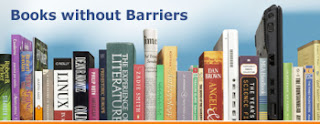My day job is in assistive technology. This means that I recommend technology solutions to people with disabilities to hopefully provide an improvement in their standard of living. For example, one of the job duties I perform involves the set-up of voice-controlled computer systems and voice-controlled environmental control units for quadriplegics. But those are just two examples.
Being in this field has some perks and one of them is knowing about all the new stuff that's being created to solve disability issues. What I wanted to talk about today has to do with how digital books can close learning gaps for students with print disabilities.
Let's start with a question: why digital books?
Well, 59% of students surveyed by the Association of Educational Publishers (May 2010) said online textbooks would have a positive impact on their learning. In contrast, only 56% said the same thing regarding laptop computers. Simply put, digital books equalize educational opportunities. Here are more statistics for you regarding digital accessible materials (a thing I found to be both exciting and surprising):
What does Bookshare offer?
They basically come from four different places. 1) Volunteers chop-up, scan, proofread, and send the books off via email. 2) NIMAC. 3) Publishers. 4) Universities.
Bookshare uses the DAISY format. But what is this exactly?
DAISY stands for Digital Accessible Information System. In other words, reading books on a computer using visual presentation and/or synthetic speech (multimodal). Examples of DAISY-Compatible AT software are:
(NOTE THAT HumanWare Victor Reader Soft and Don Johnston READ:OutLoud Windows and Macintosh both have FREE versions available for download for Bookshare members. Additionally, both feature FREE high-quality Acapela voices)
Being in this field has some perks and one of them is knowing about all the new stuff that's being created to solve disability issues. What I wanted to talk about today has to do with how digital books can close learning gaps for students with print disabilities.
Let's start with a question: why digital books?
Well, 59% of students surveyed by the Association of Educational Publishers (May 2010) said online textbooks would have a positive impact on their learning. In contrast, only 56% said the same thing regarding laptop computers. Simply put, digital books equalize educational opportunities. Here are more statistics for you regarding digital accessible materials (a thing I found to be both exciting and surprising):
- 95% graduated on time.
- 85% improved academic achievement.
- 55% increased time spent in general education classrooms and decreased the time spent receiving special education services.
- 95% decreased reliance on human assistance.
- 55% experienced increased levels of parent satisfaction.
- Checkout the National Center on Accessible Instructional Materials for more information.
What is Bookshare? Bookshare is an online library of accessible media for individuals with print disabilities. Bookshare believes that people with print disabilities should have the same ease of access to books and periodicals that people without disabilities enjoy. It operates under the Chafee Amendment to U.S. Copyright Law, worth a read and located here. It's funded by an award from OSEP, the Office of Special Education Programs in the U.S. Department of Education. Because of this award, Bookshare can offer memberships and books to all U.S. students for free. As of January 2011, it has more than 125,000 members, more than 8,000 schools and other organizations, more than 95,000 titles, and more than a thousand new books added every month.
What does Bookshare offer?
- Digital books for individuals with print disabilities.
- FREE memberships for qualified U.S. students through the OSEP award
- FREE assistive technology software.
- 24/7 access to books.
- 2,300 + K-12 textbooks with images.
- College/University textbooks.
- Classroom Reading Books.
- New York Times Bestsellers.
- Newberry, Caldecott Winners.
- 1,000 books in Spanish.
- More than 75 publisher partnerships.
- 270 national and regular newspapers and magazines.
They basically come from four different places. 1) Volunteers chop-up, scan, proofread, and send the books off via email. 2) NIMAC. 3) Publishers. 4) Universities.
Bookshare uses the DAISY format. But what is this exactly?
DAISY stands for Digital Accessible Information System. In other words, reading books on a computer using visual presentation and/or synthetic speech (multimodal). Examples of DAISY-Compatible AT software are:
(NOTE THAT HumanWare Victor Reader Soft and Don Johnston READ:OutLoud Windows and Macintosh both have FREE versions available for download for Bookshare members. Additionally, both feature FREE high-quality Acapela voices)
- Don Johnston READ:OutLoud Windows and Macintosh.
- HumanWare Victor Reader Soft.
- Kurzweil 3000.
- TextHelp Read & Write Gold.
- Freedom Scientific WYNN.
- Freedom Scientific OpenBook.
- GhPlayer.
- Dolphin EasyReader.
- DAISY Consortium AMIS.
- Nextup TextAloud.
- Innovative Rehabilitation Technology eClipseReader.
- DAISY software players.


